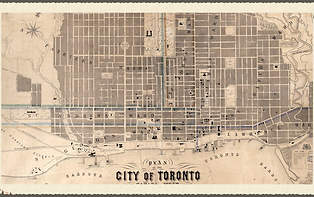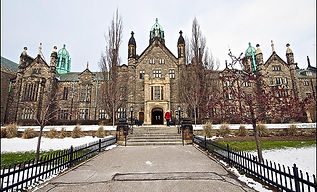
The History of Trinity College


Trinity College is a small academic college with a long and illustrious history within the University of Toronto, the largest university in Canada.
Trinity was founded in 1851 by the venerable John Strachan, the first Anglican Bishop of Toronto. Strachan had arrived in 1799 in Upper Canada as a teacher and established his first school at Cornwall. In 1827, he obtained a royal charter for the University of King’s College at York (Toronto), an Anglican school, which admitted its first students in 1843. Despite Strachan's strong opposition to the move, on January 1, 1850, King’s College became the secular University of Toronto. Gravely disappointed, he turned his attention to establishing yet another university, Trinity College, which would keep the Anglican tradition he sought to maintain. The college opened its doors on the 30th of April 1851.
Trinity College admitted its first students at a new building designed by Kivas Tully on Queen Street West on January 15, 1852. The first class consisted of fifteen divinity students, four students in Arts, and some students in Medicine. On July 16 of the same year, Queen Victoria granted Trinity College a royal charter.

During its first fifty years the College was one of the most important degree-granting institutions in Canada and its graduates in Arts, Divinity, Medicine, Law, and Music (the College also granted some degrees in Pharmacy and Dentistry) were substantial contributors to society in Canada, the United States, England, and other parts of the world. The first female student was admitted in 1883, and in 1888 Trinity established St. Hilda's College for women at 48 Euclid Street with Miss Ellen Patteson as principal, putting the College in the forefront of the movement for female higher education. St. Hilda’s had 2 students in residence.
In 1904, the College joined the University of Toronto, relinquishing its rights to grant degrees in any faculty other than Divinity. Its Faculty of Arts became part of what is now known as the Faculty of Arts and Science of the University of Toronto, though the College continued to have exclusive responsibility for certain “College subjects” until 1974. Though part of the University of Toronto, Trinity College retained its distinctive character and many independent features, including its charter, governing bodies, administration, and control over its budget, endowment, and maintenance. It now has about 1,850 undergraduate students in Arts and Science and about 140 who study at the Master's level and beyond in its Faculty of Divinity. Sports, a debating society (the Trinity College Literary Institute is the oldest university debating society in Canada), and dramatics (many well-know actors did their studies at Trinity) are among the many activities Trinity students are known for. Nearly forty of the College's students have become Rhodes Scholars.
Trinity moved to the University of Toronto St. George campus in 1925, occupying new buildings that were modeled on the old ones, at a choice location close to the other colleges, libraries, and teaching departments of the University. The college was supposed to be built from Hoskin Avenue all the way north to Bloor Street. Unfortunately, due to lack of funds after the First World War, only the Hoskin façade was constructed at the time. Students lived at Trinity House, close to where Robarts Library is today. The new St. Hilda's College building opened in 1938 on Devonshire Place after several moves along Shaw Street and St. George Street. In 1942, the construction of the East and West wings of Trinity proper was completed—this includes Strachan Hall, Owen House, Whittaker House, Henderson Tower, and Welch House. The chapel was completed in 1955 and was one of the final works of Sir Giles Gilbert Scott, better known for his design of the United Kingdom’s red telephone boxes. The north-east wing of Trinity was built in 1955 and incorporates Body House. In 1963 the quadrangle was completed with the construction of north-west wing finally incorporating Cosgrave House. The Gerald Larkin Building was finished in 1961, and the George Ignatieff Theatre in 1979. The University of Toronto's Munk Centre for International Studies at Trinity College opened in 2000; the Munk Centre is located in three beautifully renovated historic buildings, one of which houses Trinity's John W. Graham Library. The library, whose collection was formerly housed in Trinity’s basement, has roots dating back to John Strachan, and has books from all disciplines, specializing in International Relations and Theology.
A new era began for the college in 1974 when a Memorandum of Understanding was signed with the University, allowing Trinity to expand its academic program beyond its traditional courses in the humanities. New interdisciplinary programs of study were begun at the College; the first was in International Relations and it has become one of the largest in the University. The other college interdisciplinary programs are Ethics, Society and Law; and Immunology.
And the rest is history.



